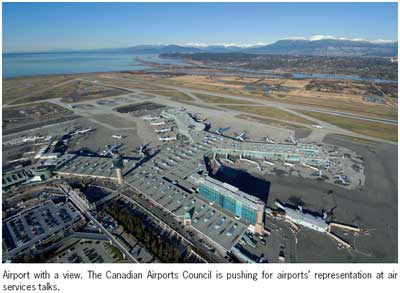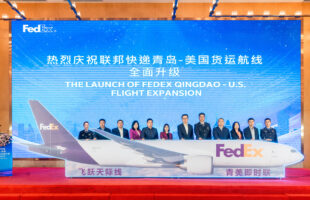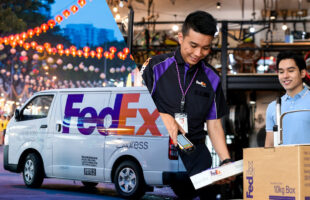
It’s tempting to observe that Canada has pretty much ‘missed the boat’ when it comes to air cargo. With an airport system long in the hands of government bureaucrats, a near solitary focus on passengers and the absence of any Canadian cargo-savvy passenger airline, let alone a globally-focused, dedicated cargo carrier, has all conspired to give air cargo a very low profile at the majority of airports across the country.
It is surprising considering the vast country was founded thanks to long distance transportation, albeit largely of the water variety. Sharing the world’s longest border with the world’s largest market, in which road and rail have traditionally been the most efficient means of moving goods back and forth between Canada and the US, has also nothelped the air cargo cause.

Change in the air
But change is, literally, in the air. A divestiture of airports by Canada’s federal government back in the early 1990s, a growing astuteness of changing trade patterns, a gradual shift to a ‘blue skies’ air services policy and closer cooperation between different levels of government and the private sector have all set in motion a new era for air cargo at the country’s airports.
One of the key changes that has set much of the later initiatives in motion was the change in airport ownership structure in which the federal government devolved control to local airport authorities under60 year operating leases.
This structure has enabled the airport authorities to invest C$9.5 billion (US$8.9 billion) in the airports since 1992, according to Daniel-Robert Gooch, communications director at the Canadian Airports Council (CAC).
The CAC was formed to promote and market 16 of Canada’s cargo airports. “Cargo has not traditionally been a really big industry for Canada compared withour potential and so the raison d’etre for our group is to raise the awarenessof Canada as a cargo gateway to NorthAmerica as an alternative to US airportswhere they’re having some real problemswith congestion,” Gooch said.
Th e focus over the last few years, he says, has been to raise awareness of Canadian airports amongst the air cargo carriers as an alternative to the US. “We have great rail and road links to the US and in the past there was often a situation where something may have been flown into Chicago, New York or Seattle and then trucked into Canada, but now we want them to fly here directly and maybe truck or rail into the US as an alternative.”
Cargo volumes have been growing he said, but there are some major constraints. Canada has not fully embraced the open skies concept with only six open skies agreements compared with nearly 95 which the US has signed on to. “There has been some real progress, especially since 2005,” he insists, pointing to a keyopen skies agreement with the US.
More liberal agreements with India and China still fall short of full open skies and a new agreement with Singapore also only reached the rung of ‘liberalised bi-lateral’, which Gooch unequivocally states, “was disappointing for us”.
Industry insiders say the reasons behind this are clear – the Canadian government was simply acting in an old-school manner by protecting the interests of the defacto Canadian flag carrier, Air Canada.
“One thing we’ve been pushing for is airports representation at the air services talks. When the US meets with someone, there’s someone from the Airports Council International (ACI) there. For Canada the carriers are there, but the airports are not.
“We were given a seat at the US open skies talks, and have been told by the government that our presence was helpful and we’ve been given observer status at the European Union (EU) talkswhich are now ongoing,” he said.
But the CAC are hopeful that the outcome of talks with the EU will result in a true open skies agreement. “For cargo in particular, that would really help us,” Gooch said. “Th e priority for the government in terms of negotiating air service agreements has traditionally been based on the carriers and in Canada we don’t have an internationally focused cargo carrier like a Cargolux, or Emirates Skycargo, so countries with these carriers, like Luxembourg or the United Arab Emirates haven’t really been on the radar screen.
“An open skies agreement with the EU would really take care of that and open things up. The all-cargo carriers are coming to us, they want the opportunity, it’s just restrictions imposed by the bilaterals that are the big impediment,”he argues.

Cargo a different animal
But Gooch is quick to add that when the government articulated its new international air policy nearly two years ago, “they recognised for the first time that cargo is a different creature than passengers – they hadn’t really done that before.
“The passenger carriers are at the talks on the Canadian side, so there isn’t really a voice for cargo at the talks, so we’ve been making the point that cargo is a diff erent animal. We argue that if you’re reluctant to do open skies on the passenger side, at least take a look at cargo.”
While he says its too early to tell if this message is getting through, a new agreement signed with the Philippines recently, although still fairly restrictive, did contain some actual rights for cargo that were diff erent – and more liberal – from the passenger rights. This could well be linked with Philippine efforts to turn the former US Clark Air Base, renamed Diosdado Macapagal Int’l Airport, into an international cargo hub.
Although he was unable to provide details, Gooch said there has been “tremendous” cargo growth since the CAC began its campaign, but also points to key challenges the airports face, particularly confl icting government policies. One particular bone of contention is the nearly C$300 million in rent that airports across Canada collectively pay to the federal government each year.
“That puts us at a competitive disadvantage, and we’re trying to point out to them that this also conflicts with their other policies,” such as trying to encourage more carriers to come to the country’s airports instead of USairports.
Asia-Pacific Gateway
A key lynch pin, particularly for the west coast of the country, is the Asia- Pacific Gateway Initiative.
An unique collaboration between senior representatives of two levels of government, three railways, two ports and the Vancouver International Airport, the initiative is squarely aimed at tapping the surging trade flows between Asia and North America – trade that is forecast to grow an astronomical 300 per cent over the next 20 years.
With a total of C$15 billion in infrastructure investments already in place, or in the process of being made, the strategy focuses on two key sea ports – Prince Rupert and Vancouver, both of which are two days closer sailing from Asia than Los Angeles and Long Beach – road and rail networks and the VancouverInternational Airport (YVR).
“At YVR we see the opportunity for signifi cant growth in traffic, both passenger and cargo,” said Kevin Falcon, Minister of Transport and Infrastructure for the western province of British Columbia.
While much of the gateway strategy focuses on ports, rail and road, there is a key aspect that includes a focus on encouraging growth of air traffic – both passenger and cargo.
Although the responsibility of his federal counterpart, Falcon said his ministry is working with YVR to encourage the federal gov
ernment to be more aggressive on open skies agreements and air bi-laterals.
“Singapore is a good example,” Falcon told Payload Asia in a recent interview. “They’ve entered into a liberalised air bi-lateral with Canada which is a good first step, but its not a full open skies agreement with 5th freedom rights that would be important to Singapore.”
“While we’re encouraged by that step in direction we think that we can do more and we ought to do more,” he added. “The government has a blue skies policy and I think that’s very encouraging. Naturally we would like things to move a bit faster, but we recognise that the federal government is also balancingother interests.”
Falcon said the initiative was the result of a soul-searching assessment a few years ago which led to the conclusion that a new strategy was needed in order to avoid missing out on the dramatic changes to world trade flows – specifically the shift to strong flows from Asia to North America.
At that point it was obvious that British Columbia (BC) was uniquely positioned to tap this he says. “We’re the closest piece of real estate to Asia which means we have the potential to capitalise on the geographic advantage, both in air and in shipping and if we invested on a coordinated basis in our ports and airports and brought about the kind of policy changes necessary we could make BC the kind of preferred gateway into North America for those in the shipping and air freight transportation business.”
But doing that meant that the government couldn’t do it on its own and what came out of it was this unique public/private sector initiative, driven by senior executives of both governmentand private enterprise.
This initiative has now picked up momentum further afi eld, from hundreds to thousands of kilometres further east and north from Vancouver, with airports in Prince George, BC; Edmonton and Calgary, Alberta; and Winnipeg, Manitoba also hoping to tap the gateway’seast and southeastern flows of cargo.

YVR a key component
But most of all, it’s Vancouver that hopes to reap the most of this new integrated strategy. Cargo at Vancouver has come under sharp focus barely two years ago with creation of a dedicated cargo marketing position.
“Historically the airport has always been focused on passenger growth and as a result Vancouver has become very much a passenger gateway, but now we are focusing more and more on cargo development,” said Alix Li, YVR cargo marketing manager.
He says it’s a general trend amongst older airports in Canada, who are now recognising – along with governments – the contribution of cargo and the economic spin-offs air cargo creates. A freighter service can actually create a good number of jobs, Li contends. He also gives due credit to Calgary International Airport in the neighbouring province of Alberta, some 1,000 km to the east for stealing the march on Vancouver by actively working to attract cargo carriers nearly five years ago.
The three-runway – two of which are 24-hour – Vancouver airport is currently the third largest cargo airport in Canada behind Toronto and Montreal, according to Li, with 230,000 tonnes of cargo throughput annually. “Going forward we are hoping the cargo traffi c will reach 500,000 tonnes by 2027. Bellycargo now makes up about 65 per cent of volumes with maindeck cargo comprising therest.
But Li acknowledges that given what is happening now with the slowing global economy and record high fuel prices dampening air cargo demand, it may be an ambitious goal. “But we have a strategic location, because we are the major city and airport on the west coast that is closest to Asia and in the days of high fuel costs, the less the airlines are flying the more they save on fuel.”
Currently YVR has three services a week by Cathay Pacific Cargo on the backhaul from the US en route to Hong Kong via Anchorage. Cathay built up its presence over the years, according to Li and prior to their cargo service through YVR, there was virtually no air cargo market in Vancouver.
“But once you have a service here and shippers know you have an established freighter service from Cathay carrying seafood and perishables, then the market starts to develop,” which is why the Hong Kong-based carrier is considered YVR’s fl agship carrier both in terms of cargo and passengers.
Air Canada is also a key bellyhold cargo contributor, but became a smaller cargo player after giving up its maindeck cargo business – both trans-Atlantic and trans-Pacific – earlier this year.
The rest of YVR’s cargo volumes come largely from the integrators – FedEx, UPS and DHL – as well as, domestic cargo airline, Cargojet.
Cargojet is eyeing an international service out of Canada, which could aid YVR’s cargo ambitions, but nothing hasbeen announced thus far.
YVR’s business proposition
Among YVR’s selling points are its strategic location, outbound commodity potential. “We are a very important perishables export market – seafood, fruit and berries and Perishables International operates the facility, which is the largest perishables centre in western Canada,” he said.
The other selling point is sea-air traffic with the port located 13 kilometres from the airport. “It used to be a very important business for the airport but due to competition from Dubai, that segment dropped off but is now picking up again.”
The airport’s cargo facilities also boast more than one million square feet of warehouse space, but Li says that the facilities are not being fully utilised with the current cargo throughput of 230,000 tonnes. “Th is means we have a lot of under utilised capacity to attract new cargo.”
Li said the airport is always open to discussing incentives with airlines and currently YVR is offering a 25 per cent discount on international cargo landing fees. In terms of competition, Seattle’s Sea-Tac Airport, Calgary Int’l Airport and Anchorage are all key competitors. But as newer aircraft with increasingly greater range are pressed into service, Li sees this as an advantage for YVR’s efforts to attract cargo and even possibly tech stops. Currently a B747-400 with full payload, departing anywhere from Shanghai, China northwards can make it direct to Vancouver without stopping at Anchorage, he said.
“So going forward as the aircraft types become more efficient and able to go longer range, it will be a golden opportunity for us.”
In the meantime, Li says Asia in general and China in particular are the key target markets and YVR is talking to a number of airlines, but no firm commitments have come through yet.
“I would also love to have some maindeck capacity out of Europe, but Cargolux for instance, already flies out of Seattle and Calgary. “It would have to be a pretty compelling business case to convince them to drop Seattle, something he readily admits would be a tough sell, although Sea-Tac’s new third runway has displaced a fair bit of cargo facilities,industry insiders say.








